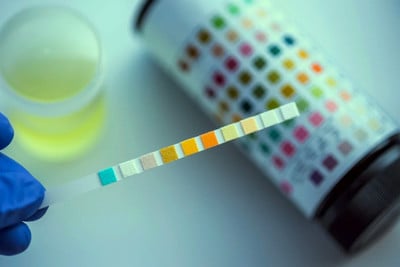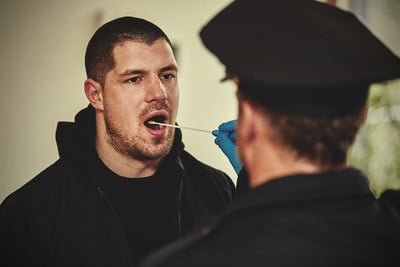.

Secondhand Marijuana Smoke: Will It Show on a Drug Test?
How potent is secondhand marijuana smoke? Will it cause you to fail a drug test? With the help of scientific facts and research, we'll provide you with answers to these questions.
Contents:
Here’s the situation: you’re at a party with a bunch of friends. One of them lights up a joint and starts passing it around. Everyone partakes except you. You’re abstaining in preparation for your pre-employment drug test in two days. But, you end up inhaling most of the smoke in the room. Occupational hazard.
This begins to ring some alarm bells in your head. Your mind starts to go into overdrive. "Is it possible to fail a drug test without smoking?". "Will I end up testing positive for cannabis and not get the job? I didn’t even take a puff!".
For those who love their magic herb, this situation has likely happened one too many times. It’s a predicament that poses a legitimate question: can you fail a drug test from secondhand smoke?
What Are the Effects of Secondhand Weed Smoke?
As it turns out, it isn’t as completely harmless as one may think. TThis 2016 study[1] on lab rats showed changes in the arterial flow for at least 90 minutes. Here’s the kicker: these symptoms showed up after just one minute of secondhand cannabis smoke exposure.
Then there’s the question of a "secondhand high" or "contact high". Based on the research, it all depends on the situation.
Let’s take this 2015 Johns Hopkins University study[2] as reference. It involved two experiments: the first one had its 12 subjects cramped in a small, unventilated room for an hour. Six of them were smokers, while the other six weren’t.
The smoking group burned through ten “high potency joints” that each contained 11.3% THC (not high potency by current recreational standards). Their non-smoking counterparts eventually began experiencing a more “pleasant” sensation, but also felt less alert and a bit more tired.


The second experiment was instead done in a ventilated room. In this case, the non-smokers didn’t feel the same effects, except for “hunger”. However, the study was done around lunchtime, so that could’ve been a factor.
Researchers eventually concluded that a contact high from secondhand weed smoke is indeed possible. However, smoking needs to be done “under extreme unventilated conditions” to cause minor impairment.
-
Can Marijuana Smoke Be Absorbed Through the Skin or Hair?
Short answer: yes to both. Let’s start with hair absorption, which, based on research, can get tricky. This dissertation [3], for instance, exposed that darker hair holds in more THC than lighter hair. That essentially puts dark and red hair at a disadvantage when it comes to hair follicle drug tests compared to blondes.
The explanation[4] is that dark-haired people have a higher concentration of melanin. Melanin apparently holds onto some drugs at a much higher rate.
Skin absorption is quite expected, given the existence of topical cannabis. Cannabinoids like THC and CBD are lipophilic[5] in nature. That means they will dissolve in fats, making it easier for them to penetrate the skin. However, they have a lower bioavailability, especially without absorption enhancers, and will not easily reach the bloodstream.


What Does Research Say About Secondhand Marijuana Smoke?
In a previous section, we discussed the possible physiological and behavioural effects of secondhand marijuana smoke.
Cannabis smoke exposure can affect a person biologically through their specimen samples.
In a 2015 study[6], a total of 26 individuals were called in to participate. Eight were cannabis users with an average of 12 smoking years. They reportedly consumed around 1.5 grams of marijuana per day. On the other end of the spectrum were 18 non-users.
All test subjects were situated in a specifically designed smoking chamber, wearing disposable paper clothing. They were scheduled to participate in three experimental smoking sessions that lasted an hour each. Urine, blood, hair, and oral fluid specimens were later collected, despite this, only the urine samples were analysed.
Two types of cannabis strains were used in the study. One had a lower THC content at 5.3%, and the other had a much higher potency at 11.3%.
The overall results indicated that with “extreme smoke exposure”, trace amounts of THC may show up in a drug test. However, it would have to be at the lowest cutoff levels. The cutoff level determines the concentration of a substance in your specimen samples that signals a positive result.
Will I Fail a Drug Test From Secondhand Marijuana Smoke?
So, does secondhand smoke show up on a drug test?
For the most part, no. Having trace amounts of THC in your system does not necessarily equate to a drug test failure. As we mentioned in the section above, drug tests require certain cutoff levels to determine a positive or negative result. Below, we explain this concept in more detail.
-
Blood and Urine Drug Tests
Unlike urine tests, which test for THC metabolites, blood tests look to detect THC itself, and are typically only conducted in hospital settings. As such, urine testing is the standard, and far more common.
In the US, the cutoff level for THC – specifically THCCOOH - in urine is 50ng/ml[7]. The non-smoker participants in the aforementioned experiment produced levels of around 20ng/ml of THC.
A similar experiment[8] was done in the Netherlands in 2010. Eight volunteers were exposed to three hours of cannabis smoke in a coffeeshop. The highest level of THC found in the participants was at 7.8ng/ml. This figure was way lower than the 25ng/ml limit at the time.


-
Saliva Drug Test
In 2004, a study[9] was done on five active marijuana smokers. All of them were placed in a room and made to smoke cannabis cigarettes with a very low THC content of 1.75%. The participants smoked for the first 20 minutes, but the volunteers lasted in the room for four hours.
Even with that lengthy exposure, the saliva collected from them afterward had THC concentrations ranging from 3.6 to 26.4ng/ml. These figures under those conditions were still way below the current limit of 50ng/ml.
-
Hair Follicle Drug Test
As we mentioned in an earlier section, darker-coloured hair holds in more THC than lighter-coloured hair because of the melanin. But is it enough to cause a drug test failure?
Let’s take this 2015 study involving two experiments. The first one had a lone participant take 50mg of THCA-A daily over a 30-day period. Despite these high levels, the THCA-A found in the individual’s hair analysis was less than 1% by weight.
The second experiment had two participants taking dronabinol, an oral form of THC medication used to treat appetite loss. The two individuals took three 2.5mg capsules per day over a 30-day period.
The result: no THC was detected when their head hair, beard hair, and body hair were all sampled.


What To Do if You’re Worried About Secondhand Marijuana Smoke
We’ve presented to you several studies. The overall verdict is that the likelihood of failing a drug test from passive inhalation of secondhand weed smoke is slim to none, especially under ventilated conditions.
But, if you’re still worried, here are few things you can do:
- Stay away: If you’re invited to a party and you know full well that there will be cannabis around, just say no.
- Hydrate: Flush your system with water around 24 to 48 hours before your test. The idea is to dilute those trace amounts of THC in your urine.
- Take some zinc: Zinc helps reduce the detection of THC in one’s system for the following 12 to 18 hours. You’ll find zinc supplements in your local pharmacy.If you use it, do it following the exact chemist's recommendations.
Hopefully, this article gave you the peace of mind you were looking for!
- One Minute of Marijuana Secondhand Smoke Exposure Substantially Impairs Vascular Endothelial Function https://www.ahajournals.org
- Non-Smoker Exposure to Secondhand Cannabis Smoke https://www.ncbi.nlm.nih.gov
- Practical Aspects of Drug Testing in Human Hair https://www.samhsa.gov
- FAA Medical Certification & Drug Testing https://www.leftseat.com
- Absorption – A Complete Guide https://www.cannify.us
- Non-Smoker Exposure to Secondhand Cannabis Smoke https://www.ncbi.nlm.nih.gov
- Cutoff levels for drugs and drug metabolites https://www.nrc.gov
- Concentrations of delta9-tetrahydrocannabinol and 11-nor-9-carboxytetrahydrocannabinol in blood and urine after passive exposure to Cannabis smoke in a coffee shop https://pubmed.ncbi.nlm.nih.gov
- Passive cannabis smoke exposure and oral fluid testing https://pubmed.ncbi.nlm.nih.gov
- https://www.researchgate.net/publication/279846256_Delta9-Tetrahydrocannabinolsaure_A_-_Studien_und_Untersuchungen_zur_Anwendung_als_Cannabis-Konsummarker_in_der_forensischen_Toxikologie
- https://www.ncbi.nlm.nih.gov/pmc/articles/PMC4595642/








































